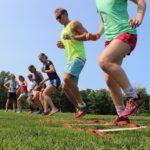Greetings from Loveland, Colorado, where John Hale and his crew have done another remarkable job of creating mid-season training conditions by the middle of October. As I am out here helping prepare a variety of racers for a very busy early season of races, I have been thinking a great deal about what it takes for you to achieve what I consider to be an essential goal in all of your efforts, namely, when you cross the finish line of your first (and, in fact, every) race, you are make two statements:
- “I was as prepared as I could be to ski my fastest and achieve my goals.”
- “I left it all out on the hill.”
Over the last few weeks, I’ve been thinking about a way to communicate a process that will help you take the necessary steps to ensure that you can make those statements. In doing so, I have come up with my Three Steps to Ski Racing Success:
- Perspective
- Preparation
- Performance
Perspective
I have been focusing on this issue extensively in the last year or so, particularly because I’ve been working with a remarkable group of racers who have already achieved considerable success which tells me that they already have pretty darned good mental skills (though they would agree that there is always room for improvement). So I asked myself, “How can I help them step up to the next level when they already have so many of the skills necessary for ski racing success?”
What I realized is that all of the best fitness, technique, tactics, equipment, and mental skills will go for naught if you don’t begin with the right perspective. If you have the right perspective, you set the stage that will allow all of your preparations to be expressed in skiing that is intense, focused, free of any concerns that might hold you back, and fully committed to skiing as fast as you possibly can.
When I talk about perspective, I mean how you look at our sport and your involvement in it. This perspective influences what you think about, the emotions you experience, and how you ski in both training and races. Though I will explore perspective in much more detail in a future article, here are some of the most important components of perspective that you should develop:
- Your reasons for ski racing
- Your sense of ownership of your ski racing
- How you define success and especially failure
- Your willingness to seek out discomfort in pursuit of improvement
- Whether you perceive races as threats or challenges
- Your willingness to take risks
- Whether you’re more focused on the process or the outcome
- Your ability to stay focused in the present rather than the past or future
If you can develop a healthy perspective in these areas, you will set the stage for the next step in my progression.
Preparation
The greatest perspective in the world won’t help you achieve your racing goals if you don’t then do the hard work necessary to be totally prepared to ski your best. As we all know, a lot of things go into skiing your fastest. Preparation is so important because it is the only thing you have total control over in your ski racing. You can’t control the genes your parents gave you, the weather, snow conditions, terrain, or your competitors. There are so many areas that impact your ski racing and any area that is not fully prepared will cost you essential tenths and hundredths of seconds. You must ensure that you develop every piece of this ski racing puzzle.
There are, of course, a high level of physical health and fitness, solid technique and tactics, and well-prepared equipment. And we can’t forget the essential role that the mind plays in ski racing success (I would never let that happen!). There are also some lesser considered contributors including rest, school or work, and relationships, all of which can either push you toward or away from success.
There are three primary mental areas you need to develop in your preparations. First, all of your efforts at getting yourself totally prepared should lead to high confidence in all aspects of your skiing. Confidence is so important because, even if you have everything you need to ski your fastest, you won’t use those things unless you really believe in them. Second, you must train your body to reach and maintain your ideal level of intensity before every training run. Without that correct intensity, your body won’t be physiologically capable of skiing well. Third, you must develop a consistent and narrow focus that enables you to concentrate on those things that will help you ski well and avoid distractions that interfere with good skiing. Mental imagery and training routines are two essential mental skills that will foster quality training and total preparation.
As you enter this new race season, ask yourself if you have everything covered; have you done everything you can to achieve your goals. If you haven’t, I have no sympathy for you because you could have (sorry if that sounds harsh, but it’s true). If you have, you are fully prepared to enter the final step in my progression to ski racing success.
Performance
Everything you’ve accomplished so far, in terms of both perspective and preparation, is devoted to enabling you to ski your fastest when it matters most. But being capable of performing your best doesn’t always translate into great skiing. In fact, the #1 reason why racers come to me is because they ski really well in training, but they just can’t replicate that skiing in races. Why is this such a difficult thing to do? Because racing is different than training; it matters. Races are where you put your preparations to the test. Races are where you will either live up to or crumble under the weight of expectations—yours and others. Races are where you will feel excitement or trepidation. Races are where you will either experience the “thrill of victory or the agony of defeat” (you have to be pretty old to remember where that quote came from).
Here is where perspective, which you will hopefully have established at the start of this progression, must return to accomplish this goal. Perspective will keep races in, well, perspective, reminding you that ski racing is important to you, but not that important. Ski racing is a part of who you are and your life, but it doesn’t define you and it is not life itself. Perspective will liberate you to experience races as a challenge to pursue with gusto rather than a threat to avoid in fear. It will enable you to take the risks necessary to ski as fast as you can.
Here is also where your great preparations are funneled into a state of physical and mental readiness on race day that enables you ski in the race the same way you ski in training. Your training has given you a deep confidence in your ability to go all out and ski your fastest. It also ingrained your ideal intensity and focus so deeply that, in the start area, you reach those same levels that enable you to ski your best. As with training, continuing the use of mental imagery and extending your training routine to your race routine ensures that you are totally physically and mentally prepared to ski your fastest.
Your ultimate goal in this three-step progression is to hurl yourself out of the starting gate and down the hill with confidence, intensity, and focus, without doubt, worry, or fear holding you back.
If you can harness these three steps to ski racing success, you set yourself up to ski your very best and achieve your ski racing goals. Just as importantly, you give yourself the opportunity to experience what it feels like after a race run and say, “I left it all out on the hill.”





